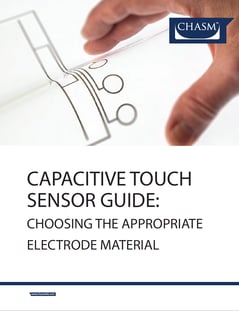3 Electrode Material Optical Characteristics for Capacitive Touch Sensors
Which optical characteristics are important to review before choosing an electrode material? This article covers the basics:
Optical Characteristics
The optical characteristics of an electrode material incorporated into a touch sensor are fundamental to how the electrode will perform. The right material will be “clear” enough to provide a clean view of the screen with no obstructions. In reviewing the optical characteristics of an electrode material, it is important to focus on three factors: transmittance, haze and tint.
Transmittance
The optical characteristics of an electrode material incorporated into a touch sensor are fundamental to how the electrode will perform. The right material will be “clear” enough to not obstruct or negatively impact the view of the screen. Although some conductors can appear “clear”, they may have particular color tint giving an unwanted color cast from the screen. In reviewing the optical characteristics of any electrode material, it is important to focus on two factors: transmittance and haze.
Optical transmittance, also known as Visible Light Transmittance (VLT) indicates the fraction of visible light transmitted through the material. When looking to incorporate capacitive touch sensors into a touch screen device, this property becomes increasingly important. VLT values are measured from 0% (opaque) to 100% (transparent). For many applications in the touch screen industry, an acceptable level of VLT is generally 85% VLT or higher. However – that’s not just the measurement for the electrode material – that for the entire stack up of materials comprising the finished touch screen product. So, you’ll want an electrode material with a high VLT (90%+). For other applications such as touch buttons on a curved face or control panel of an appliance, this is also important so that any back lighting added to enhance the visual appeal of the sensors is appropriately represented.
Haze
Another important optical characteristic is haze. Haze is caused by the reflection of light within the electrode materials and the presence of haze causes a cloudy/murky look on the touch screen. As such, engineers and designers typically target a limit of 2% or less for haze. This does depend on the application of your capacitive touch sensors, so it’s always good to know the appropriate level for your application or product.
Tint
A third and final optical characteristic to mention is tint. Some commercially available ITO alternatives have a color cast to the material. If you plan to back light your sensors and you want a neutral light or bright white light, you’ll need to consider the inherent color properties of your electrode material to ensure it does not create an unwanted tint that will adversely affect your design.
There are 3 other characteristics to review when choosing an electrode material: Electrical, Mechanical and Environmental. Looking to learn more about each category? Download the eBook:
4 Key Electrode Material Characteristics to Think About When Designing a Capacitive Touch Sensor

.jpg)
























